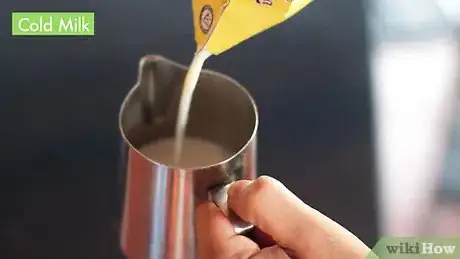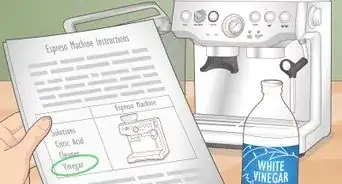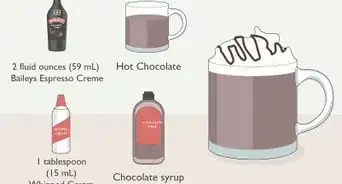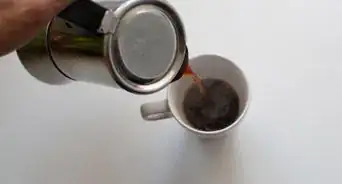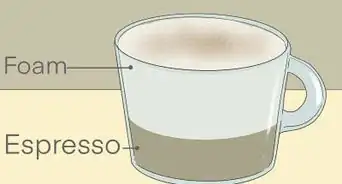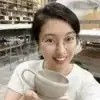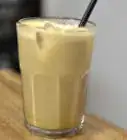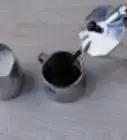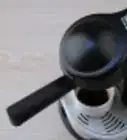This article was co-authored by Jaden Zhao and by wikiHow staff writer, Jessica Gibson. Jaden Zhao is a Barista and the Owner of Jiaren Cafe & Yoga Studio in Santa Clara, California. Her cafe specializes in matcha drinks, espresso, coffee, fruit drinks, and herbal drinks. Additionally, the cafe hosts classes and features a yoga studio and a community space. Jaden earned an MS from Santa Clara University Leavey School of Business and a BA from the University of Wisconsin-Madison.
wikiHow marks an article as reader-approved once it receives enough positive feedback. In this case, 100% of readers who voted found the article helpful, earning it our reader-approved status.
This article has been viewed 1,926,927 times.
While many agree that making good espresso is an art within itself, latte art refers to patterns made in the foam topping espresso drinks. To make these beautiful designs, ensure that your milk is properly steamed and that your espresso has great crema, the delicate foam on top of the espresso shot. You'll be able to free pour or draw beautiful art in the foam in no time!
Steps
Making Perfect Foam
-
1Pour cold milk into a chilled pitcher. Try to chill a metal steam pitcher about 30 minutes before you want to make latte art. Remove the cold pitcher and pour in cold milk until it reaches the bottom of the spout. This will give the milk room to expand and foam as it heats.[1]
- For example, if you have a 12-ounce (355 ml) pitcher, pour in about 10 ounces (295 ml) of milk.
- Because of its high fat content, whole milk is easier to steam than skim or low-fat milk.
- If you don't have an espresso machine at home, you can use a French press to froth your milk.
-
2Purge the steam wand and insert it into the milk pitcher. Point the steam wand away from you and turn it completely on for a few seconds. This will clean the wand of any milk that may be stuck in the wand. Turn it off and immediately lower it towards the bottom of the pitcher.[2]
- The steam wand should be pointing diagonally towards the back of the pitcher near the handle.
Advertisement -
3Turn on the steam wand and insert a thermometer. Turn the steam wand on as soon as you've lowered it into the milk. If you want to check the temperature of the milk, insert a thermometer onto the side of the pitcher. Slowly bring the wand up in the milk so it's near the top. The milk should be swirling like a whirlpool.[3]
-
4Heat the milk until it reaches 140 to 145 degrees F (60 to 63 degrees C). Lower the steam wand back down so it's about 1 centimeter (0.4 in) away from the top of the milk. The milk should not stretch too much nor should there be any big bubbles. This will create smooth, velvety microfoam instead of dry, stiff foam.[4]
- The microfoam is steamed milk that is made up of many tiny bubbles. This makes a softly textured milk that's easy to pour into art.
- Keep in mind that the milk will continue to heat for a little bit after you've turned off the steam wand. Avoid overheating the milk or you'll increase the risk of burning yourself.
- Once you get used to steaming milk, you probably won't need the thermometer. With a little experience you can usually tell how hot the milk is by just feeling the temperature of the pitcher.
-
5Turn off the steam wand and tap the milk. Shut off the steam and take the thermometer out of the steam pitcher. Tap the pitcher of foamed milk on the counter and then swirl the milk gently to prepare it for pouring.[5]
- Swirling the milk will get rid of any big bubbles in the foam that could make it hard to pour.
-
6Clean the steam wand. Take a wet cloth and thoroughly wipe the steam wand as soon as you've finished heating the milk. Purge the steam wand by turning it completely on for a few seconds. This will clear out any milk that's been left inside the wand.[6]
- Remember to wipe off the thermometer, if you used one.
Pulling Your Espresso
-
1Dose and tamp the espresso. Measure about 7 to 8 grams of espresso for each shot into a clean portafilter. Use the tamp to press down evenly on the grounds so you're giving it about 30 to 40 pounds (13 to 18 kg) of pressure. Avoid leaving the tamped espresso to sit for very long in the portafilter, especially if the portafilter is hot. This could burn the espresso.[7]
- You can practice pushing down on a bathroom scale to figure out how hard to press down on the portafilter.
-
2Pull the shot. Immediately put the portafilter into the espresso machine and turn it on. It will take a few seconds before the espresso begins to drip out of the machine into your shot glass or small pitcher. Give the double shot about 21 to 24 seconds before you turn it off. You should notice a creamy foam at the top of the shot. This is the crema.[8]
- With a little practice, you should be able to start the espresso and steam the milk at the same time. This will ensure that neither the espresso nor steamed milk sit for long.
-
3Troubleshoot or practice your shots. You may need to practice just pulling shots of espresso before you make latte art. If you find that the espresso is taking too long to get into the cup, you may have packed the portafilter too tightly. Or if the espresso immediately pours into the cup once you start the shot, you may need to tamp down harder or use more espresso.[9]
-
4Use the espresso right away. Slowly pour the espresso shots into a wide-mouthed serving cup or mug to keep the crema on top. The crema is what will make your latte art really stand out. If you let the shot sit for too long (more than 10 seconds) before you pour in the steamed milk, you won't get much definition in your designs.[10]
- A wide-mouthed cup will give you more space for your latte art.
Pouring the Milk into a Design
-
1Pour some of the milk into the espresso. Hold the wide-mouthed cup with the espresso in your non-dominant hand. Tilt the cup about 20 degrees towards the pitcher of milk that you're holding in the other hand. Slowly pour steamed milk directly into the espresso until the cup is about halfway full.
- The goal is to keep the rich crema floating on top. If you pour too quickly, it can wash out the espresso which will make it difficult to create latte art.
-
2Bring the pitcher close to the cup. Once the cup is half full, you can tilt the wide-mouthed cup back until it's straight up. At the same time, move the pitcher of steamed milk right above the surface of the espresso. You should see some of the white microfoam appear in the espresso. You can now start making a design.
-
3Create a heart design. Once you see the white dot of microfoam in the cup, keep pouring right into it. You should get a large white circle. When you've almost filled the cup, pour the milk through the white circle towards the other side of the cup. This pulls the milk through the circle to create the heart shape.[11]
- Remember that you're moving the milk and the pitcher, not the cup with the espresso.
- If the milk is too dry or stiff, you'll may end up with more of a white blob. Try it again and steam the milk so it's looser.
-
4Create a flower or tulip pattern. Stop pouring the foamed milk as soon as you see the white dot against the crema. Wait a second and then pour another dot right behind the first dot. Continue making as many dots as you like until you're ready to pour the milk through the dots. This will connect all of them and make the dots look like leaves.[12]
- You're basically making a little heart from the final dot. The end of the heart becomes the stem for the flower.
-
5Make a rosetta design. As soon as you see the white dot of microfoam in the crema, use your wrist to gently rock the milk from side to side as you pour it into the cup. The white microfoam should begin to fan out. Continue rocking the milk until the cup is almost full and the design is almost covering the top of the cup. Lift the milk pitcher up a little and pour directly through the milk towards the other side of the cup.[13]
- Avoid using your whole arm to rock the milk into the cup. This will give you less control over the design.
Etching and Drawing Latte Art
-
1Etch a design or words in the foam. Take a toothpick or skewer and drag it through the foam on the top of the latte to create your own patterns or art. This works well even if your foam isn't made of delicate microfoam. You can even use etching to create words in the foam.
- Consider drizzling a syrup over the top of the foam before you drag the toothpick through it. This can create a web-like effect or allow you to write words easier.
-
2Make art with a stencil. You can buy stencils that you simply place over the finished latte. Shake cocoa powder, cinnamon, or a spice mix over the stencil and lift away the stencil. This will leave the image of the stencil on top of the latte.
- You can make your own latte stencil using thin plastic or wax paper. Use a blade to carefully cut away the design you want into the plastic. You can set this over the latte like a stencil.
-
3Use chocolate for unique designs. For a unique design, sprinkle some cocoa powder over the espresso in the cup before you pour the milk into it. When you pour the milk over it, the latte will look darkly speckled. You can also make swirls in the foam using chocolate syrup.
- Experiment by drawing webs, snowflakes, or flowers using chocolate syrup.
Expert Q&A
-
QuestionHow do you train for latte art?
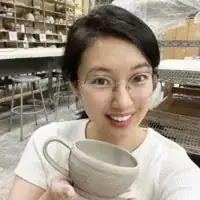 Jaden ZhaoJaden Zhao is a Barista and the Owner of Jiaren Cafe & Yoga Studio in Santa Clara, California. Her cafe specializes in matcha drinks, espresso, coffee, fruit drinks, and herbal drinks. Additionally, the cafe hosts classes and features a yoga studio and a community space. Jaden earned an MS from Santa Clara University Leavey School of Business and a BA from the University of Wisconsin-Madison.
Jaden ZhaoJaden Zhao is a Barista and the Owner of Jiaren Cafe & Yoga Studio in Santa Clara, California. Her cafe specializes in matcha drinks, espresso, coffee, fruit drinks, and herbal drinks. Additionally, the cafe hosts classes and features a yoga studio and a community space. Jaden earned an MS from Santa Clara University Leavey School of Business and a BA from the University of Wisconsin-Madison.
Barista It helps to watch YouTube videos and take classes! In-person classes are the best option, because you'll get feedback. It's important to learn about the milk texture, as well as controlling the flow of milk for higher and lower positions.
It helps to watch YouTube videos and take classes! In-person classes are the best option, because you'll get feedback. It's important to learn about the milk texture, as well as controlling the flow of milk for higher and lower positions. -
QuestionHow do you practice latte art without espresso?
 Jaden ZhaoJaden Zhao is a Barista and the Owner of Jiaren Cafe & Yoga Studio in Santa Clara, California. Her cafe specializes in matcha drinks, espresso, coffee, fruit drinks, and herbal drinks. Additionally, the cafe hosts classes and features a yoga studio and a community space. Jaden earned an MS from Santa Clara University Leavey School of Business and a BA from the University of Wisconsin-Madison.
Jaden ZhaoJaden Zhao is a Barista and the Owner of Jiaren Cafe & Yoga Studio in Santa Clara, California. Her cafe specializes in matcha drinks, espresso, coffee, fruit drinks, and herbal drinks. Additionally, the cafe hosts classes and features a yoga studio and a community space. Jaden earned an MS from Santa Clara University Leavey School of Business and a BA from the University of Wisconsin-Madison.
Barista Use a very solid concentrate like tea! As long as there's a color difference, you can do latte art.
Use a very solid concentrate like tea! As long as there's a color difference, you can do latte art. -
QuestionWhat is the easiest latte art shape?
 Jaden ZhaoJaden Zhao is a Barista and the Owner of Jiaren Cafe & Yoga Studio in Santa Clara, California. Her cafe specializes in matcha drinks, espresso, coffee, fruit drinks, and herbal drinks. Additionally, the cafe hosts classes and features a yoga studio and a community space. Jaden earned an MS from Santa Clara University Leavey School of Business and a BA from the University of Wisconsin-Madison.
Jaden ZhaoJaden Zhao is a Barista and the Owner of Jiaren Cafe & Yoga Studio in Santa Clara, California. Her cafe specializes in matcha drinks, espresso, coffee, fruit drinks, and herbal drinks. Additionally, the cafe hosts classes and features a yoga studio and a community space. Jaden earned an MS from Santa Clara University Leavey School of Business and a BA from the University of Wisconsin-Madison.
Barista The heart is the easiest shape to make—it only requires basic techniques. Plus, every type of latte art is based on the heart shape.
The heart is the easiest shape to make—it only requires basic techniques. Plus, every type of latte art is based on the heart shape.
Warnings
- Steam is very hot so take care not to burn yourself.⧼thumbs_response⧽
Things You'll Need
- Whole milk
- Espresso
- Straight walled steam pitcher with a sharp spout
- Espresso machine with a powerful steam wand
- Shot glass or small pitcher
- 14 ounce (400 ml) latte cup
- Thermometer
- Toothpick or skewer
- Stencil
Expert Interview

Thanks for reading our article! If you'd like to learn more about latte art, check out our in-depth interview with Jaden Zhao.
References
- ↑ https://bluebottlecoffee.com/preparation-guides/milk-and-art
- ↑ http://makezine.com/2016/01/03/skill-builder-steam-milk/
- ↑ https://bluebottlecoffee.com/preparation-guides/milk-and-art
- ↑ https://bluebottlecoffee.com/preparation-guides/milk-and-art
- ↑ https://athome.starbucks.com/recipe/how-make-latte-art-home
- ↑ https://bluebottlecoffee.com/preparation-guides/milk-and-art
- ↑ http://www.coffeescience.org/latte-art-beginners-guide/
- ↑ http://www.coffeescience.org/latte-art-beginners-guide/
- ↑ http://www.coffeescience.org/latte-art-beginners-guide/
About This Article
To make latte art, first make frothed milk by pouring cold whole milk into a chilled metal steam pitcher, then inserting a steam wand and heating it until it’s between 140 and 145 °F. Slowly pour the milk into a cup of espresso, tilting the cup at a 20-degree angle. Once the cup is half-full, stand it up straight and continue pouring until you see a patch of white microfoam on top. To make a heart shape, keep pouring the milk and draw a stirring stick through the center. To create a flower pattern, make small dots of milk and connect them with a stirring stick. For tips on how to use a stencil to make latte art, scroll down!
